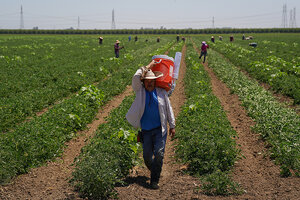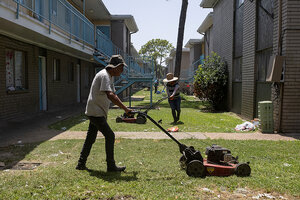As extreme heat rises, so do concerns for worker safety

Ernesto Hernandez carries a water cooler to set up a hydration station while enduring high temperatures near Winters, California, July 13, 2023.
Loren Elliott/Reuters
AUSTIN, TEXAS
Near the end of his first day working at the construction site, John Guerrero Jr. stopped sweating. He didn’t know the danger he was in.
It was late May, and temperatures had reached 96 degrees Fahrenheit as he helped to install interior walls, ceilings, and doors at the site in east Austin, according to a federal investigation. Drinking water and Gatorade during his three breaks wasn’t enough. By the end of the day, he died of heat stroke.
Mr. Guerrero was one of at least 279 people to die due to heat in Texas last year, according to The Texas Tribune. And at least 42 Texas workers died from heat-related illnesses on the job between 2011 and 2018, according to data from the U.S. Bureau of Labor Statistics. Given that there is no perfect way to measure heat-related deaths, both figures are likely undercounts.
Why We Wrote This
Record-breaking heat this summer has raised risks for millions of American workers in hot conditions. This is helping to spur a rethink of how the country manages extreme heat and labor.
This statistical uncertainty – estimates of how many people die from heat each year in the United States range from 153 to over 10,000 – is part of a broader lack of clarity, and perhaps even concern, across the country about the dangers posed by extreme heat. As summers have become hotter in recent decades, one fact has become increasingly clear: The U.S. treats heat emergencies differently from other natural disasters.
Extreme heat is the deadliest kind of weather disaster the U.S. faces, but unlike what happens amid most other extreme weather events, life has been expected to continue as normal during severe heat waves. While a hurricane might shut a city down, a bad heat wave often doesn’t. Thanks to air conditioning, many Americans can avoid the worst dangers. But certain workers – like those in construction, transportation, and agriculture – can’t.
Workers have faced these dangers for years with few protections. Now, as millions of Americans have baked under record-breaking heat – nearly 40% of Americans faced heat advisories last week, according to the National Weather Service – the risks they face are helping spur a broader rethink of how the country manages extreme heat and labor.
“We haven’t really focused on extreme heat as a climate hazard,” says Ladd Keith, an assistant professor at the University of Arizona who researches heat policy in urban areas.
“We’ve seen a huge change in that in the last couple of years, and that is in part due to an increasing awareness,” he adds. Heat “is breaking records and impacting people’s lives.”
Efforts to keep workers safe
When it comes to heat safety, Austin, Texas, has been ahead of the curve.
In 2010, as policy director of the Workers Defense Project, an advocacy group for low-wage, immigrant workers in Texas, Greg Casar led the effort to establish a city ordinance requiring employers to give construction workers a 10-minute rest break every four hours – the bare minimum of protections, according to experts. Now, as a U.S. congressman representing the city, he’s helping lead efforts to create federal standards to keep workers safe in extreme heat.
“This is a basic human decency issue,” says Representative Casar, a Democrat and former Austin city councilor.
“Some important preliminary actions [are happening], but they need to be followed up with much stronger actions,” he adds.
Only five states have heat safety standards. Every other state is subject to federal workplace safety rules set by the Occupational Safety and Health Administration (OSHA), but the only regulatory tool the agency has for extreme heat is the catchall general duty clause of the Occupational Safety and Health Act of 1970.
The clause requires employers to shield workers from hazards causing or likely to cause “death or serious physical harm.” And when it comes to heat-related workplace injuries and deaths, it’s been difficult to enforce, experts say.
“The burden of proof for showing a violation of that clause [is] extremely high,” says Juanita Constible, a senior climate and health advocate at the Natural Resources Defense Council in New York.
“And fines are often too low to dissuade that behavior, especially when employers can negotiate down,” she adds.
After Mr. Guerrero died, for example, OSHA issued his employer a $4,351 fine, according to public records. Another employer argued a $7,250 fine down to $2,175, according to public records, after an employee died of heat stroke while digging irrigation trenches. The mother of a San Antonio man who died last summer laying fiber-optic cables on a 101-degree day is suing his employer.
What limited rules exist in Texas may soon disappear as well. There are no statewide heat safety rules in Texas, and in September a new state law aimed at creating a uniform regulatory code across the state would effectively nullify local rest break ordinances for construction workers in Austin and Dallas.
Supporters of that law say the varying city ordinances create a patchwork of regulations that hurt businesses in the state, and members of the Texas construction industry say most employers are already doing their best to keep workers safe.
“The challenge you will always have with this particular issue is every single job site is different, and every single task on a job site is different, so it’s hard to write a one-size-fits-all rule,” says Geoffrey Tahuahua, president of the Associated Builders and Contractors of Texas.
“I’d more so look at what is the behavior we want to encourage, and make sure we’re encouraging that as much as possible,” he adds. “As OSHA inspectors make their way [around] Texas, I think they’ll find there’s a lot of people doing the right thing.”
Last month, Democrats filed a bill in the Texas Legislature that would create heat illness prevention standards to protect workers in indoor and outdoor workplaces. That legislation is unlikely to be looked at until 2025, however, when the Legislature next reconvenes.
“Early days of heat governance”
In the Southwest, scalding summer temperatures have been paired with rapid growth. Austin is a prime example.
Not only has the Austin metro region been experiencing extremely hot summers – last summer was the second hottest on record, and last month was the hottest July on record – but its population almost doubled as well between 2000 and 2020.
For Eva Marroquin, who’s been working construction in Austin since 2005, working in the summer is like stepping into an oven. You start baking from your helmet to your boots, sunlight searing against your reflective vest, she says through a translator.
“Your heart starts beating really, really fast. You feel like you have a fever, but it’s not a fever; it’s heat stroke,” she says. “I have felt it countless times.”
She’s speaking in the Workers Defense Project office, where she’s been a member since 2011. A single mother of five, she stretches her calloused hands across the table, inspecting her bare nails.
“They’re worker’s hands ... but the necessity keeps us having to work,” she says. “If we start rolling back the very little protections workers have and have fought for, it will be incredibly hard to find a dignified job.”
OSHA is working on a rule to prevent heat injury and illness in the workplace, it announced last year. That process usually takes years, however, and members of Congress like Mr. Casar want to accelerate it. Last week President Joe Biden also announced a swath of federal actions that will take effect soon, including increasing inspections of high-risk workplaces like construction and agriculture, and improving weather forecasts.
“It would be fair to say it’s the most heat-focused administration in the country’s history,” says Dr. Keith at the University of Arizona.
“They’re addressing this in the way you’d hope: a whole-of-government response through multiple agencies,” he adds. “Having said that, we’re at the very early days of heat governance.”
And the workplace is one of many arenas where more awareness of heat safety is needed, experts say, especially as extreme heat begins to touch every corner of the country.
“This summer is not a preview of the future,” says Dr. Keith. “The climate we’re living in today [has] already been influenced by climate change, and the future will be even hotter unless we drastically reduce greenhouse gas emissions.”
In June, shipping company UPS reached an agreement with the Teamsters union to install air conditioning in all of its new trucks. It’s part of a larger tentative agreement in July that, if accepted, would avoid a strike by over 340,000 unionized employees around the country.
Oregon offers heat safety lessons
There were no heat safety rules in Oregon in 2021 when a deadly heat wave hit the Pacific Northwest. The 54 people who died didn’t have air conditioning at home, and only a half-dozen had portable air-conditioning units, most of which were either unplugged or not working, according to the county medical examiner. In total, roughly 1,200 people from Oregon to British Columbia may have died of heat-related illnesses due to the event, almost matching the total number of deaths in Hurricane Katrina.
Two years later Oregon is poised to become a national leader in heat safety. The new rules enacted by the state last year – which include detailed requirements around access to shade, access to drinking water, and training for supervisors and employees – are the only heat safety rules in the country that apply to both outdoor and indoor workers.
Ms. Constible of the Natural Resources Defense Council is “most excited” about the Oregon rules, “but it’s too early to tell if it’s working,” she says. “And as with any regulation, enforcement is key.”
Detailed heat safety rules are already in place in other areas, such as sports and the military. The U.S. Marine Corps has used flag conditions corresponding to temperature and heat acclimation of personnel to train safely since the 1950s. The U.S. Army created a heat center at Fort Moore (formerly Fort Benning) that researches and shares heat safety information with other military branches.
“These aren’t some lefty wacko ideas,” says Ms. Constible.
“I really hope we can come together to find a solution to a preventable problem that has the chance to take away a family member, a loved one,” she adds.


